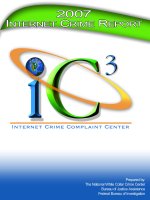Bookshelf Online_ IC3 Spark1-10
Bạn đang xem bản rút gọn của tài liệu. Xem và tải ngay bản đầy đủ của tài liệu tại đây (1.62 MB, 8 trang )
<span class='text_page_counter'>(1)</span><div class='page_container' data-page=1>
•
•
•
PRINTED BY: Printing is for personal, private use only. No part of this book may be
reproduced or transmitted without publisher's prior permission. Violators will be prosecuted.
Lesson 1: Operating Systems Basics
Lesson Objectives
In this lesson you will learn how to start a computer and access the operating system. You will also be introduced
to Windows. On completion you will be familiar with:
how an operating system works
how to start and exit Windows
what the Windows desktop is
how applications differ from operating systems
how to use the Start button
how to navigate around the desktop
how to use the taskbar
how to start the Control Panel
how to change the display of the desktop
What is an Operating System?
Objective 11.1
A computer is a collection of electrical and mechanical parts that we refer to as hardware. Each part performs its
own job, and all the parts must be able to communicate in order for the computer to work correctly.
<i>Instead of “talking” to one another directly, these parts all talk to the operating system. An operating system is a</i>
program in charge of communication and organization. It keeps all the working parts organized and running
smoothly.
You, as a computer user, “talk” to the operating system whenever you log on to the computer, or type on the
keyboard, tap on a touchscreen, or use an application program such as an email program or a word processor.
The operating system has some very important functions:
it manages hardware devices, and
it controls communication among the hardware devices, and
it controls communication between application programs and hardware devices
It works like this:
As you work in your application program, the program “talks” to the operating system, and the operating system
“talks” to the hardware devices that perform the tasks and store your work. As the work is performed, the
hardware “talks” to the operating system, and the operating system “talks” to the application program, which in
turn “talks” to you.
Differences between software applications and operating systems
</div>
<span class='text_page_counter'>(2)</span><div class='page_container' data-page=2>
•
•
•
•
•
•
and application programs.
While both are software, there are some important differences:
Application programs are used to produce work. You use application programs to create documents or
spreadsheets or presentations.
An operating system manages devices and makes sure that communication takes place between an
application program and the hardware devices.
An operating system also manages files stored on the computer.
OS Evolution – from the Dinosaur Days to Today
“OS” is an abbreviation for operating system. And over the years, they have evolved from simple text screens to
full color pointandclick (or tap) screens.
Disk Operating System (DOS) was the original operating system developed for the personal computer (PC).
When you first started the computer, you were greeted by a flashing cursor called a command prompt.
And that was it! No userfriendly desktop. You began working on the computer by typing commands at the
command prompt. It was from here that you could manage files and start programs.
Today, operating systems communicate with you through a graphical user interface (GUI), or “gooey.”
GUI is a fancy name for a system that lets you use menus and clickable buttons or icons to start programs, move
files, or perform other tasks.
The GUI makes it possible for you to "point and click" in order to perform most tasks. This makes it easy for new
users to work with the operating system and get things done.
Here’s a Tip:
An interface is a point where two systems (or people, or devices) meet and communicate with one
another. Anytime you use a computer, you communicate with it through a user interface.
Modern Operating Systems
Today, you can choose from several operating systems. You might like Windows, while your best friend prefers
Mac OS, and your teacher likes Linux.
All operating systems include a “desktop” which is the screen that opens once you log on and are ready to begin
working. Desktops usually include colorful backgrounds, icons or buttons for accessing commands, and a status
bar to show which programs are open and running.
Some of the most popular operating systems include:
Windows
Windows operating systems are designed by Microsoft. Recent versions are:
Microsoft Windows 10
Microsoft Windows 8
Microsoft Windows 7
The Windows 8 and Windows 7 desktops are shown here:
</div>
<span class='text_page_counter'>(3)</span><div class='page_container' data-page=3>
•
•
•
•
•
•
•
–
–
–
–
•
Mac OS X is designed by Apple Inc. for Macintosh computers. Recent versions are:
Version 10.9 – Maverick
Version 10.10 – Yosemite
Version 10.11 – El Capitan
The Mac OS X Yosemite and Maverick desktops are shown here:
Linux
Linux is a free operating system. You can find Linux installed on supercomputers – such as those used by Google
and NASA. But it is also installed on millions of home computers. Because anyone who uses Linux can modify it, it
is very popular with power users (users who like to program).
Versions of Linux are called distributions – or “distros” for short. Some popular distros are:
Knoppix
Ubuntu
Gentoo
The Knoppix and Ubuntu desktops are shown here:
UNIX
UNIX was one of the earliest operating systems and was first designed for use on large mainframe computers
and servers. Modern versions are available for desktop systems, and include a GUI; however, the GUI is
separate from the operating system.
Specialized Operating Systems
Most operating system developers (Windows, Mac, Linux, and so on) make specialized versions to run on
different types of devices.
Handheld Operating Systems are used on Smartphones and tablets. These are scaleddown versions of the
operating system. That is, they are smaller and perform fewer tasks. Popular handheld operating systems
include:
Windows Phone (based on Windows)
Android (based on Linux)
iOS (based on Mac OS X)
Blackberry (a mobile operating system designed for Blackberry phones)
</div>
<span class='text_page_counter'>(4)</span><div class='page_container' data-page=4>
1.
•
•
2.
a.
b.
c.
d.
•
•
required by the specific devices for which they are developed.
Try It! Exercise
In this activity, your instructor will show two short videos that highlight the look and feel of three modern
operating systems. The first video shows a brief tour of Ubuntu Linux, and the second video compares the
appearance and features of Windows 10 and Mac OS X El Capitan.
Teacher: Open a web browser and play the following videos:
Tour of Ubuntu Linux (approx. 3 minutes) />
Windows 10 vs Mac OS X El Capitan (approx. 2 minutes) />v=uqwU3q4Yhgc
Teacher: After showing the video(s), close the browser and lead a short discussion on the following
questions:
Do you think these operating systems are very different from each other, or do you think they seem to
offer the same basic features and capabilities?
What do you think are the major features highlighted in each video?
What factors might you consider when deciding which operating system to use?
Which one looked most interesting to you?
Common Operating System Features
Objective 11.1, 11.3
No matter which operating system you use, certain features are common among all of them.
User Accounts
In addition to managing communication, devices, and file storage, an operating system keeps track of who is
using the computer. You may be lucky enough to own your own computer, or you may share a computer with
family members or with classmates when you are in school.
It is easy to share computers because each person who uses it can have his or her own account. You can think
of an account as a special area on the computer where you can work and keep your files, separate from other
users.
An account name (and usually a password) is associated with each account.
When you first turn on a Windows computer, one of two things can happen:
If you are the only user on the computer and your user account does not require a password, then you will
be automatically logged on to your account and the Desktop appears.
If you are using a computer on which multiple user accounts have been set up, or if your user account
requires a password, then Windows displays an icon and account name for each user account and you must
log on to your account by clicking your account icon and entering your password.
</div>
<span class='text_page_counter'>(5)</span><div class='page_container' data-page=5>
1.
2.
1.
2.
Power On / Power Off
You press the power button to turn the system on; however, you should never just press the power button to turn
the system off. You should always use the operating system's Power Off or Shut Down option.
Powering On the Computer
Perform the following steps to correctly power on a computer:
Turn on devices that are connected to the system unit (such as the monitor and speakers and maybe a
printer) first.
Turn on the system unit.
Several lines of information are displayed on the screen; the computer performs a startup test and then loads
the operating system files into memory.
When the operating system is loaded, Windows will display a Welcome screen, quickly followed by the Windows
desktop.
If the computer is connected to a network or set up for multiple users, Windows will display a logon screen before
you get to the desktop. A sample logon screen is shown here.
If a logon screen displays, click the icon for your user account (or enter your login ID), type your password and
press . When you have logged on successfully, the Windows Desktop displays.
Powering Off the Computer Properly
Power Off procedures are built into an operating system to ensure that no information is lost or damaged. To
properly power off a Windows computer:
Click the Start button – this will show you the Shut Down button.
Click Shut down to finish powering off the system. The computer closes all files and programs, closes the
operating system and turns off the power completely.
Shut Down Options
Did you notice that the Shut down button includes an arrow? Click the to see other things you can tell the
computer to do.
Switch
</div>
<span class='text_page_counter'>(6)</span><div class='page_container' data-page=6>
1.
2.
3.
4.
5.
not close the operating system. The log on screen displays again.
Lock When you use the Lock option, Windows hides the desktop behind a log on screen. All the
programs and files you were using stay open and ready, but only the log on screen shows and
you must enter your password before you can start working on them again.
Restart Windows closes all open files and programs, exits the operating system and restarts the computer
without turning off the power. Sometimes when a computer starts to behave strangely or seems to
get "lost" or "stuck" restarting it will make it run properly again. Restarting clears the memory and
reloads the operating system, but does not cause the computer to perform the startup tests again.
Sleep Clicking Sleep leaves the computer on, but puts it into a mode where it uses less power. The
screen turns off and often the computer fan stops. Sleep mode helps to save battery power on
laptops. Windows puts your work into memory. When you wake the computer, the screen will look
exactly as it did when you put it to sleep. On a desktop computer, the Sleep command may be
listed as Standby.
Hibernate This option is found on laptops only. When you click Hibernate, the computer writes your open files
and programs to a storage location and then turns off the system. When you press the power
button on a laptop in hibernation, the system starts back up and puts your files and programs back
into memory. You can start working again right where you left off.
To turn off Sleep or Standby mode and return to normal working mode, simply move the mouse or press a key on
the keyboard. To turn off hibernation, press the power button on the laptop.
Try It! Exercise
In this exercise you will turn on the computer to start the operating system. You will also log on to Windows and
explore various Shut down options. If you need help finding objects on the screen, ask your teacher for help.
Identify where the power buttons are located on your computer and the monitor.
Turn on the monitor, then press the power button to turn the computer on.
Watch the monitor to see the messages that display.
If a Windows logon screen appears, click the icon for your user account and enter your password to log on to
Windows. (Ask your teacher for help if you need to.) When you have successfully logged on to Windows, the
Desktop displays.
</div>
<span class='text_page_counter'>(7)</span><div class='page_container' data-page=7>
6.
7.
8.
9.
10.
11.
12.
13.
14.
15.
16.
17.
18.
19.
20.
Point the mouse pointer over the Shut down options arrow so you can see the Shut down options menu.
(Ask your teacher for help if necessary.)
In the Shut down options menu, click Switch user to access the log on screen. If there are many accounts on
the computer, an icon will display for each user account.
Click the icon for your user account and enter your password if necessary to return to the Desktop.
Point the mouse pointer over the Shut down options arrow to see the Shut down options menu again.
In the Shut down options menu, click Log off to log out of your account and return to the Windows log on
screen.
Click the icon for your user account and enter your password, if necessary, to return to the Desktop.
Display the Shut down options menu again.
In the Shut down options menu, click Lock to lock the system.
The Desktop is now hidden by a log on screen.
Click the icon for your user account or enter your password if necessary to return to the Desktop.
Display the Shut down options menu, then click Sleep (or Standby) to put the computer to sleep.
The screen goes dark. Has the power light changed color?
Press a key on the keyboard or press the power button to wake the computer. Depending on how your
teacher has set up your computer, you may need to click the icon for your user account or enter your
password to return to the Desktop; otherwise, you will be returned to the Desktop immediately.
If necessary, click the icon for your user account or enter your password to return to the Desktop.
Display the Shut down options menu, then click Restart to restart the system.
Windows shuts down, and then starts again without performing startup tests that run when you first power on
the system.
When the log on screen displays, click the icon for your user account and enter your password if necessary
to access the Desktop.
</div>
<span class='text_page_counter'>(8)</span><div class='page_container' data-page=8>
21.
22.
Windows shuts down, and then the system turns off.
Press the power button on the computer to start the system.
Log on to Windows.
Looking at the Windows Desktop
Objective 11.2
</div>
<!--links-->
<a href=' /><a href='http://https//www.youtube.com/watch?v=uqwU3q4Yhgc'>Windows 10 vs Mac OS X El Capitan (approx. 2 minutes)









